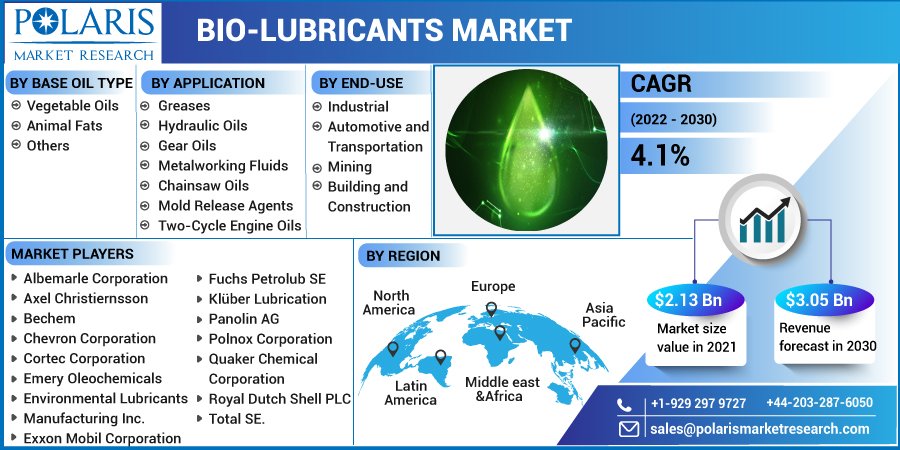According to the research report published by Polaris Market Research, the global bio-lubricants market was valued at USD 2.13 billion in 2021 and is expected to reach USD 3.05 billion by 2030, to grow at a CAGR of 4.1% during the forecast period.
Market Overview:
The bio-lubricants market is gaining momentum as industries shift towards sustainable and environmentally friendly alternatives to conventional petroleum-based lubricants. Bio-lubricants are derived from renewable sources such as vegetable oils and animal fats, making them biodegradable, non-toxic, and less harmful to the environment. These lubricants are widely used across various sectors, including automotive, marine, industrial machinery, and agriculture, offering superior lubrication performance while reducing carbon footprints.
With stringent environmental regulations and increasing consumer awareness about sustainability, bio-lubricants are emerging as a preferred choice for industries looking to minimize environmental impact and enhance operational efficiency. Advancements in bio-based formulations and technological innovations are further boosting the adoption of bio-lubricants in high-performance applications.
Key Trends in the Market:
- Development of High-Performance Synthetic Bio-Lubricants – The industry is witnessing advancements in synthetic bio-lubricants that offer enhanced thermal stability, oxidation resistance, and extended service life.
- Growing Adoption in Electric Vehicles (EVs) – The shift towards EVs is increasing the demand for specialized bio-lubricants designed to optimize battery cooling, gear lubrication, and overall vehicle efficiency.
- Expansion of Renewable Feedstock Sources – Researchers and manufacturers are exploring alternative bio-based raw materials, such as algae-derived and waste-based oils, to improve sustainability and production efficiency.
- Integration of Nanotechnology in Bio-Lubricants – The incorporation of nanomaterials in bio-lubricant formulations is enhancing their tribological properties, reducing friction, and extending machinery lifespan.
- Rise of Eco-Friendly Certification and Labeling – Industry players are focusing on obtaining eco-certifications such as the EU Ecolabel and USDA BioPreferred to enhance market credibility and consumer trust.
- Increase in Collaborations and Strategic Partnerships – Companies are engaging in joint ventures, mergers, and acquisitions to expand their bio-lubricant portfolios and enhance market reach.
Major Key Players:
- Albemarle Corporation
- Axel Christiernsson
- Bechem
- Chevron Corporation
- Cortec Corporation
- Emery Oleochemicals
- Environmental Lubricants Manufacturing Inc.
- Exxon Mobil Corporation
- Quaker Chemical Corporation
- Royal Dutch Shell PLC
- Total SE
𝐄𝐱𝐩𝐥𝐨𝐫𝐞 𝐓𝐡𝐞 𝐂𝐨𝐦𝐩𝐥𝐞𝐭𝐞 𝐂𝐨𝐦𝐩𝐫𝐞𝐡𝐞𝐧𝐬𝐢𝐯𝐞 𝐑𝐞𝐩𝐨𝐫𝐭 𝐇𝐞𝐫𝐞:
https://www.polarismarketresearch.com/industry-analysis/bio-lubricants-market
Recent Developments:
- RSC Bio Solutions and SSOH Partner for Bio-Lubricant Distribution in Japan (December 2021) – RSC Bio Solutions entered into a strategic partnership with Standard Sekiyu Osaka Hatsubaisho Co., Ltd (SSOH) to expand the distribution of environmentally acceptable lubricants (EALs) in Japan. This collaboration aims to meet the increasing demand for sustainable lubrication solutions in marine and industrial applications.
- Neste and Hesburger Collaborate on Waste Cooking Oil Recycling (October 2021) – Finnish oil refiner Neste partnered with Hesburger, a leading restaurant chain, to collect waste cooking oil from over 300 restaurants across Finland. The recycled oil will be utilized in the production of bio-lubricants and renewable diesel. Additionally, Hesburger committed to using Neste’s MY Renewable Diesel to power its entire transportation fleet in Finland, further promoting sustainability.
- Royal Dutch Shell Expands Lubricant Production Facility in Indonesia (March 2020) – Royal Dutch Shell announced the expansion of its lubricant production facility at Marunda Centre, Indonesia. Following the expansion, the plant will have an increased production capacity of 300 million liters of lubricant, strengthening Shell’s ability to meet the growing demand for high-performance lubricants in the region.
- FUCHS Group Strengthens Presence in Sub-Saharan Africa (December 2019) – To enhance its footprint in Sub-Saharan Africa, FUCHS Group acquired a 50% stake in three distribution firms based in Zimbabwe, Zambia, and Mozambique. This strategic investment aims to expand FUCHS’ market reach and improve the availability of high-quality lubricants in the region.
𝐒𝐞𝐠𝐦𝐞𝐧𝐭𝐚𝐥 𝐀𝐧𝐚𝐥𝐲𝐬𝐢𝐬:
The research study includes segmental analysis that divides the market into distinct groups or segments based on common characteristics. With market segmentation, businesses can identify specific customer groups that are more likely to be interested in specific products or services. Also, it enables these businesses to focus their marketing efforts and resources more efficiently, leading to higher conversion rates and improved return on investment. Furthermore, segmentation analysis helps companies develop personalized products or services, which can result in increased customer loyalty and improved customer satisfaction.
Bio-lubricants Market, Base Oil Type Outlook (Revenue – USD Billion, 2018 – 2030)
- Vegetable Oils
- Animal Fats
- Others
Bio-lubricants Market, Application Outlook (Revenue – USD Billion, 2018 – 2030)
- Greases
- Hydraulic Oils
- Gear Oils Metalworking Fluids
- Chainsaw Oils
- Mold Release Agents
- Two-Cycle Engine Oils
- Others
Bio-lubricants Market, End-Use Outlook (Revenue – USD Billion, 2018 – 2030)
- Industrial
- Automotive and Transportation
- Mining
- Building and Construction
- Others
The future of the bio-lubricants market is promising, driven by increasing environmental awareness, regulatory support, and technological advancements in bio-based formulations. As industries strive to reduce their ecological footprint, the demand for bio-lubricants is expected to rise across diverse applications, including automotive, marine, industrial machinery, and energy sectors.
𝐁𝐫𝐨𝐰𝐬𝐞 𝐌𝐨𝐫𝐞 𝐑𝐞𝐬𝐞𝐚𝐫𝐜𝐡 𝐑𝐞𝐩𝐨𝐫𝐭𝐬:
Industrial Batteries Market Opportunities

